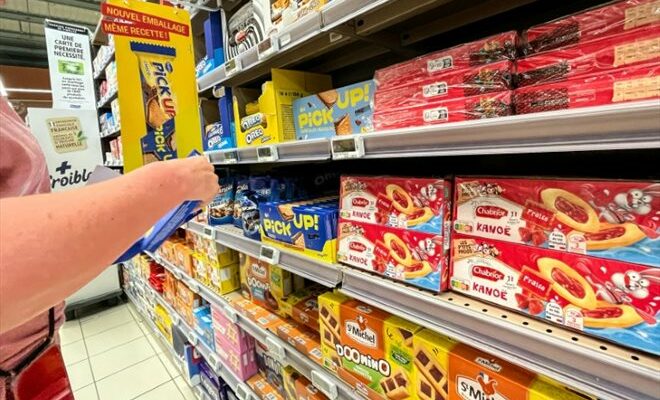In the chips section in a supermarket in Septèmes-les-Vallons (Bouches-du-Rhône), November 3, 2022 (AFP/Archives/Christophe SIMON)
Cereals, compotes, chips… On supermarket shelves, a very small number of agro-industrialists sometimes hide behind the profusion of brands and the concentration which began a long time ago has not been interrupted by inflation .
For breakfast, there are plenty of choices between Coco Pops, Frosties, Smacks, Cheerios, Chocapic and even Golden Grahams. Behind these brands, two agro-industrial giants: Kellog’s and Cereal Partners Worldwide, a joint venture owned by Nestlé and General Mills.
Between them, they control 75% of their market, that of national brand breakfast cereals in France, according to anonymized data from the Federation of Commerce and Distribution (FCD), the professional association of supermarkets.
These data do not take into account the share of private label brands (MDD), held by supermarkets. More or less a third of supermarket sales are made in private label, and the proportion tends to increase because customers see it as a buffer against rising food prices and because supermarkets strongly push them.
– Multinationals or cooperatives –
According to internal documents from one of the distribution players, consulted by AFP, Kellog’s represents almost a third of sales in its cereal department.
And the domination of one or two players is not only observed in the breakfast aisle, according to anonymized data from the FCD. The latter did not wish to disclose the identity of the industrialists, which AFP was confirmed by two sources familiar with the matter.

In a supermarket in Toulouse (Haute-Garonne), September 4, 2023 (AFP/Archives/Charly TRIBALLEAU)
In infant food, Danone (Blédina) and Nestlé share 77% of the national brand market. Lactalis and Sodiaal, 72% of the milk section. PepsiCo (Lay’s) and Intersnack (Vico, Monster Munch and Tyrell’s), 68% of the chips section.
In the compote sections (MOM/Materne and Andros/Bonne Maman) and cooked pork ham (Herta and Fleury Michon), the two leaders even monopolize 92% and 91% of sales.
Among these dominant players, multinationals, such as Mars, Mondelez (Lu, Oreo), Lactalis (Galbani, Leerdamer, President), Danone (Danette, Actimel, Activia) or Procter & Gamble, which accounts for more than half of the department’s sales. layers of the brand previously mentioned.
But there are also cooperative companies, represented by the powerful Agricultural Cooperation. On its site, it lists its members: Agrial (Florette, Loïc Raison, Savoine or Pavé d’Affinois), Terrena (Paysan Breton, Régilait or Père Dodu), Sodiaal (Candia, Entremont or Régilait), or even Tereos (Beghin Say , L’Antillaise or La Perruche).
“The more the products require significant processing work, the fewer players there are,” notes, on condition of anonymity, one of the major French retail brands.
The factories of large groups also often produce for private labels.
But even less processed products are affected: Nestlé Waters (Vittel, Contrex, Hépar or Perrier), recently called into question over its management of the quality of its water deposits, represents around a quarter of sales in the water department. Its competitor, Danone, is close behind with nearly 24% of sales via its brands Evian, Volvic, Badoit and Salvetat.
– Supermarkets also concentrated –
The 283 largest companies in agro-industrial processing, 2% of the more than 14,000 companies in total, generate no less than 86% of the sector’s turnover, according to the FCD and its agro-industry counterpart, the ‘Ania.

On the shelves of a supermarket in Lens (Pas-de-Calais), July 11, 2023 (AFP/Archives/DENIS CHARLET)
The representative of the supermarket leader E.Leclerc, Michel-Edouard Leclerc, estimated in January in La Montagne that competition “is not significant enough” among manufacturers.
On the supermarket side, however, the concentration is significant in France, especially since the collapse of Casino has accentuated it. The three largest brands (E.Leclerc, Carrefour, Intermarché) represent 60% of the market, the 5 largest (Système U and Auchan), 80%, according to Kantar.
According to the FCD, the sector is slightly more concentrated than in Germany or the United Kingdom, and significantly more than in Italy or Spain.
For the consumer defense association Foodwatch, the six largest distributors (with Lidl) capture 60% of the money spent by the French on food.
In his eyes, the “control” of these behemoths of the food chain “allows them to impose their conditions on suppliers” and to influence “consumption practices”. She regrets that distributors and agro-industrialists are “far from favoring healthy and sustainable products, on the contrary”.
© 2024 AFP
Did you like this article ? Share it with your friends using the buttons below.




